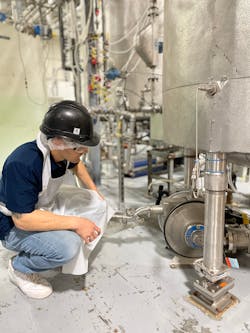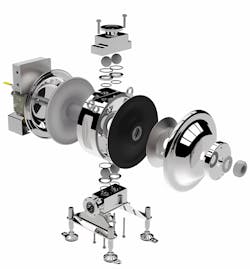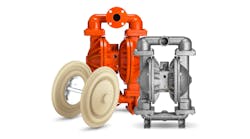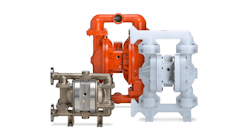Air-operated double-diaphragm (AODD) pumps are popular throughout the food and beverage industry. They are well suited to pumping viscous products ranging from olive oil to peanut butter. Because of their simple air-powered operation, they tend to be highly reliable. Nevertheless, as with any process equipment, there are a variety of tips and techniques to ensure that you get the most out of your pump operation.
During sub-optimal pump operation, processing may slow to a trickle. The faster the maintenance teams can restore pump performance, the less costly the interruption. This article offers a practical checklist for how to quickly troubleshoot an AODD pump.
Of course, before you start troubleshooting, it is always good practice to ensure all fastenings are tight and correctly torqued. If tightening and torquing does not improve pump performance, then proceed to the manufacturer’s troubleshooting guide.
If the problem appeared on an existing pump, ask the operations team this question: Has the application changed? If so, double check that operations communicated with the maintenance manager.
- Is a different process media being pumped, perhaps one with a different viscosity?
- Does the new application require a higher flow rate, perhaps beyond the normal operating limits of the pump?
- Has the cleaning procedure changed to clean-in-place (CIP)? Hot, caustic cleaning solutions may degrade seals in a pump not originally specified for CIP. What is more, CIP may be performed under high pressure. The diaphragms of the vast majority of AODD Pumps are limited to 8-10 psi on the suction side of the pump; only AODD pumps with an inside-out design can be modified with reinforced diaphragms able to withstand 100 psi on the suction side of the pump.
The pump is only one component in a system, and in the case of AODD pumps, the system includes the pneumatic system that powers the pump.
- Were there changes that reduced the air supply? Perhaps a clogged filter, leaky fitting or stuck valve?
- Did facility renovations change the process pipework? Did workers introduce a different diameter pipe or longer, less straight runs?
Check if the pump in question was recently serviced or inspected. If the pump was stripped down and reassembled, then look for incorrect assembly that could cause operational issues.
If none of these scenarios explain why the pump is not working, then it is time to roll up your sleeves and inspect the mechanical aspects of the system. The troubleshooting steps vary depending on the type of problem: the pump will not cycle or prime, the pump delivers insufficient flow or the pump leaks. This article covers each case below.
What to do if an AODD pump will not cycle
Since air operated pumps are entirely reliant on the pneumatic system for functioning, many problems can be resolved by fixing the air supply.
As a corrective measure, managers may decide to increase the diameter of the air line or increase the volume of air going to the pump. The pneumatic system must be maintained, nevertheless, in the majority of cases. Here are some troubleshooting tips:
- Air line — Inspect the main air line and ensure it is not kinked.
- Air valves — Make sure that all of the valves are open. This includes the suction, delivery and air supply lines. Inspect the air valve for free movement. The valve should move easily, but it should not be too loose.
- Air leaks — Use an ultrasonic leak detector to ensure that there are no leaks in the pipes and that there are no loose fittings.
- Line size — Match the diameter of the air line to the size of the diaphragm.
- Air volume — Check the manufacturer’s manual for volume requirements.
- Air pressure — Check the manufacturer’s manual for the correct air pressure. Typical AODD pumps require between 2 and 7 Bar to run.
- Pipework — If the air pressure equals the pressure of the product in the delivery pipework, then the pump will "dead head" and not cycle. As soon as the pressure in the delivery pipeline falls below the air pressure that is being supplied to the pump, the pump will automatically restart.
- Contamination — Look for contamination inside the pump. A dirty air supply can cause a buildup of material that may restrict movement of the air valve. Contaminants are often a cause of unequal running or stalling.
- Check the internal components of the pump. Replace the diaphragm if needed.
- Tie rod — Ensure all airways in the tie rod are clear.
- Mufflers — Mufflers (also called silencers) are fitted to the pump to reduce the noise of air escaping. If these are blocked by dirty air or product leaks, then the air cannot exhaust from the pump causing the pump to stop. Also, mufflers can also become blocked by ice-buildup if the air is moist and the pump is in a cold environment.
What to do if an AODD pump will not prime
If an AODD pump will not prime, the cause is likely somewhere in the processing pipework rather than in the air system.
- Check the application is within the pump’s capabilities. If your pump has a 3.6 m dry suction lift, but the application requires a 4.5 m dry suction lift, then the pump may not prime.
- Check that all process pipework valves are open. A closed valve in the suction pipework will stop pump priming. A closed valve in delivery pipework can cause an "air lock" that can stop pump priming.
- Check there are no leaks in the suction pipework. Any leaks can result in air getting into the pipework, displacing the product.
- Verify that the suction pipework is not collapsing under the vacuum. Suction pipework should be of a reinforced material that maintains its diameter. Also, inspect the pipework to make sure there are no kinks between the pump and the source of the product fluid.
- Check that the suction pipework is the appropriate diameter and length for the application. Thick, viscous product requires larger diameter pipework and shorter runs between the source of the liquid and the pump.
- When pumping with high-viscosity products, the best practice is to start the pump slowly. This allows the pump to prime. Once primed, speed up the pump to reach the most efficient pump operation.
- Inspect any filters in the suction line and verify that they are not clogging.
- Check for wear of internal pump components and replace as needed. These items include the divider seal, balls and seats.
Steps to take if an AODD pump is not delivering adequate flow
- Check that the application is within the pump’s capabilities. The pump manufacturer probably provided a flow chart. For example, a certain model of AODD pump with a 12-inch diaphragm and a 2-inch inlet/outlet may offer a flow rate of 390 liters per minute. It is imperative to consider that the situation may have developed since the initial selection of the pump, and therefore, the pump may no longer be suitable.
- Review the length and diameter of suction and delivery pipework for excessive turns.
- All pipework should be the same diameter as the pump inlet and outlet.
- Check the pipework “run.” Runs should not have excessive turns. Ideally, runs should be as short and straight as possible. The importance of inspecting the piping increases with the viscosity of the process medium.
- Ensure that the pump is getting enough air volume and air pressure.
- Inspect the suction and delivery lines for restrictions or partially closed valves.
- Inspect any filters in the delivery or suction lines and replace clogged filters.
- Check pump internals for wear and replace as needed, including the divider seal, balls and seats, and diaphragms.
- Check the mufflers (also known as air silencers). Restricted or blocked mufflers can cause a pump to slow down and even stop. The same thing can happen with “iced up” mufflers.
What to look for if an AODD pump is leaking process product
Nobody appreciates a puddle under their pump. In addition to the time lost in cleaning and sanitation, filthy conditions often result in the loss of valuable products. Fortunately, this situation is among the easiest to troubleshoot.
- Start by checking bolt tightness on the pump. Bolts should be torqued to the manufacturer’s specifications.
- Check manifold O rings. Replace them if they are damaged or flattened.
- If product is leaking from the mufflers, check that the diaphragms are tight. Some pumps have a backup diaphragm or alarms in case of diaphragm failure.
Whether an AODD pump is leaking, has inadequate flow, will not prime or will not cycle, managers can use the above checklists to find the root cause. Quickly finding and fixing the problem will keep production on schedule and minimize costly disruption.
Leighton Jones is the director of sales for AODD pumps for Unibloc Hygienic Technologies. Jones has more than 20 years of experience working with applications using pumps within the pharmaceutical, cosmetics, food and beverage, and chemical industries.
Unibloc Hygienic Technologies



